The Nexus 7 (2013) Review
by Anand Lal Shimpi on August 22, 2013 6:00 PM ESTCPU Performance
The while the original Nexus 7 was fast for the money, the new Nexus 7 is just fast. Moving away from NVIDIA to Qualcomm, ASUS and Google settled on the APQ8064 Pro. Although we originally assumed this would be a quad-core Krait 200 based SoC, Brian's teardown revealed the part number 8064-1AA. What's special about that part number is it implies newer Krait 300 cores, making the SoC effectively a Snapdragon 600.
The CPU cores can run at up to 1.5GHz, putting it a bit lower than what we've seen from Snapdragon 600 based phones (e.g. HTC One tops out at 1.7GHz, while the US SGS4 hits 1.9GHz).
I was curious as to the impact of the lower frequency when combined with the potentially higher chassis TDP so I compared the Nexus 7 to the US Galaxy S 4. I turned to Geekbench because it offers a nicely woven mixture of single and multithreaded benchmarks, letting me look at peak available single core performance as well as what happens when multiple cores are active and working.
In this first graph we're looking at the first Krait 300 core running the workload. I've zoomed in to a small portion of the benchmark so we can get a better idea of CPU behavior:
The Nexus 7's CPU0 is almost always pegged at 1.5GHz whereas we see a lot of bursty thermal management on the smaller SGS4. This isn't unexpected, but what ends up happening is the sustained performance advantage drops from a peak theoretical max of 26% down to a more reasonable average gain of ~8%.
I was curious to see if multithreaded workloads showed any different behavior. Here we're looking at the fourth CPU core (CPU3). Note that it's not always active, which is why you see parts of the graph drop down to 0KHz. Once again we see similarly static behavior from the Nexus 7. Even with all four cores active, when you need the performance the Nexus 7 delivers a full 1.5GHz. These tests are short enough where we don't see tremendous swings in frequency, but once again we do see some frequency modulation in a smaller chassis.
The end result is that the Nexus 7's 1.5GHz Krait 300 cores are slower than what you'd get in a Galaxy S 4, however the gap isn't nearly as large as you'd expect it to be thanks to the larger chassis and how the platform is tuned. The Nexus 7 can run at 1.5GHz more consistently than Snapdragon 600 based phones can run at 1.7/1.9GHz.
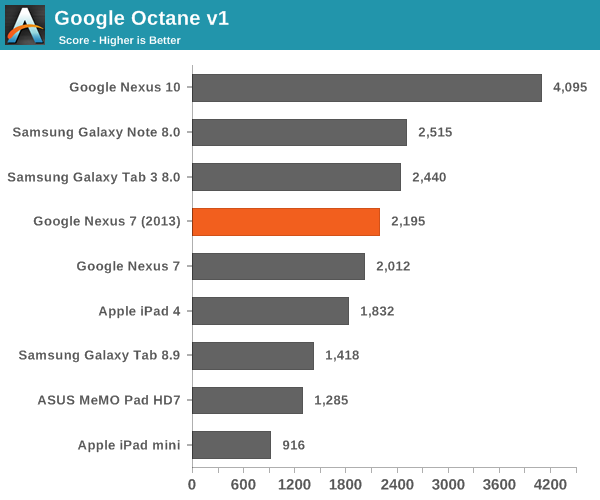


The GPU
Qualcomm seems to be frequency binning here, which is standard industry practice. Using binning to create these different SKUs gives Qualcomm pricing flexibility and also gives it the option to give large customers special treatment.
On the graphics side Qualcomm's Adreno 320 GPU makes an appearance. Clock speeds are also limited to 400MHz, compared to 450MHz for the high-end Snapdragon 600 implementations we've seen.
The APQ8064-1AA's dual-channel memory controller is populated with four x 16-bit DDR3L-1600 memory devices, giving the Nexus 7 a healthy amount of memory bandwidth. Peak memory bandwidth available to the APQ8064-1AA is 12.8GB/s, equalling what's available to Apple's A5X in the 3rd generation iPad with Retina display. Tons of memory bandwidth is obviously a pre-requisite for driving a high resolution display, and the combination of DDR3L-1600 and the Adreno 320 GPU delivers a butter smooth UI in all well written Android apps.
Although CPU performance is somewhat middle of the road compared to the rest of the landscape, GPU performance is faster than any other Nexus device on the market - and pretty much faster than any other similarly sized tablet:
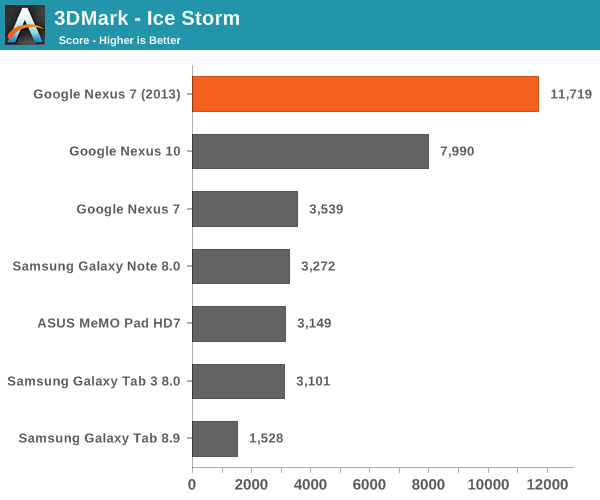
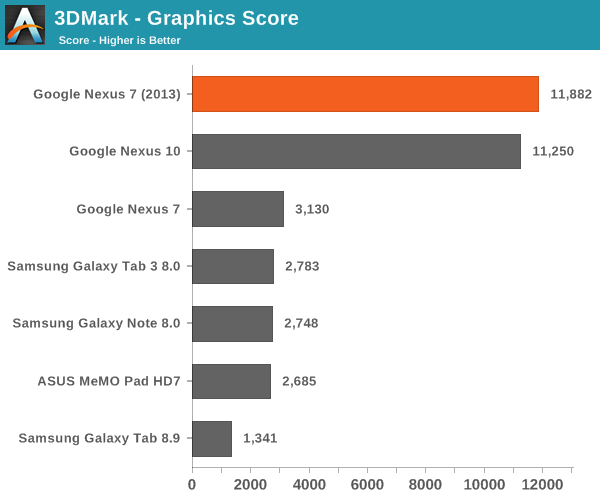
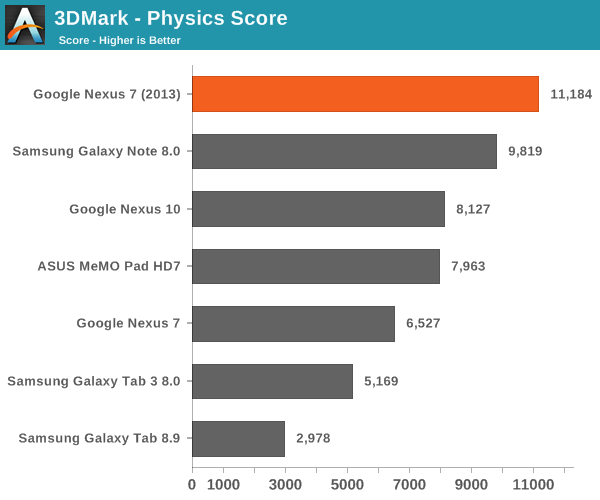
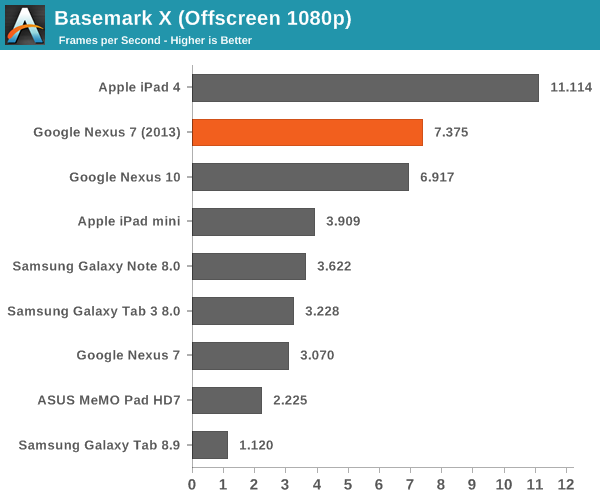
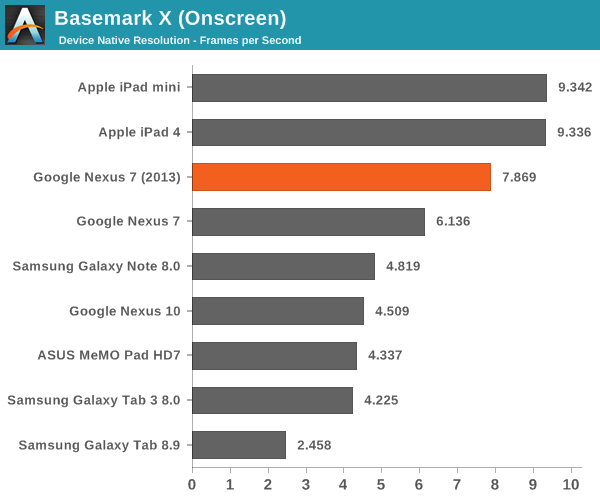
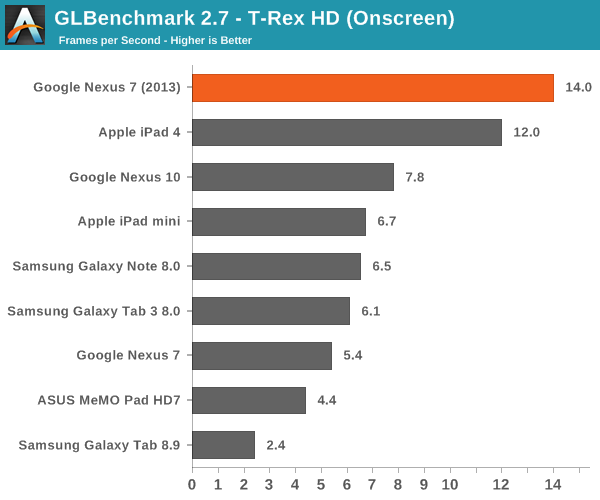
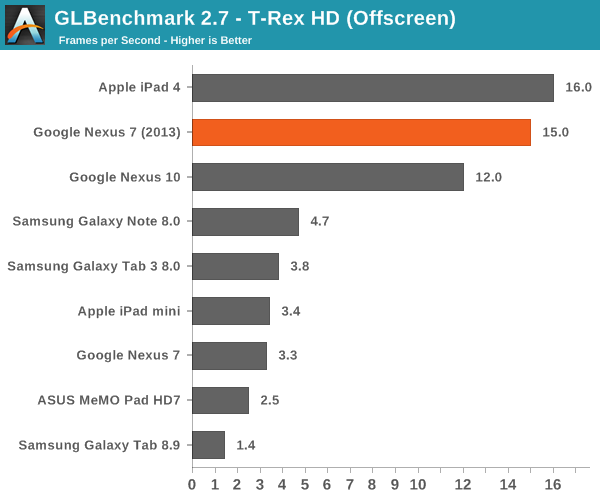
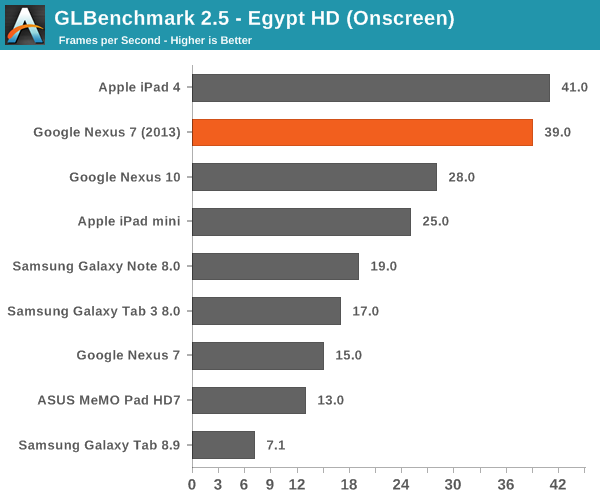
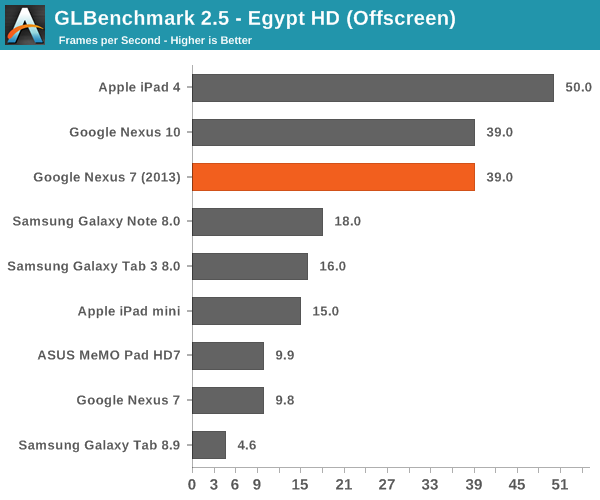
I played Modern Combat 4 as well as Shadowgun, both demanding 3D titles, on the new Nexus 7. Both titles appeared to render at the Nexus 7's native 1920 x 1200 resolution, and both appeared to do so at around 30 fps.


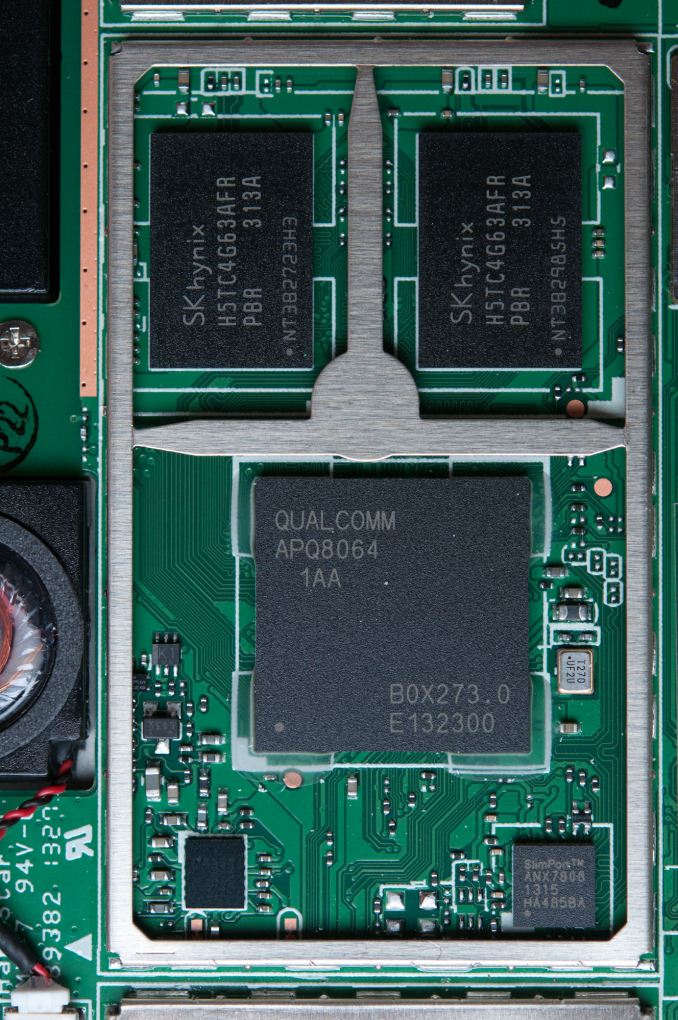
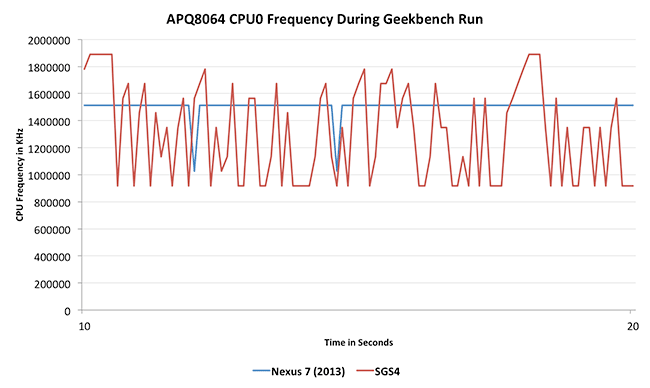
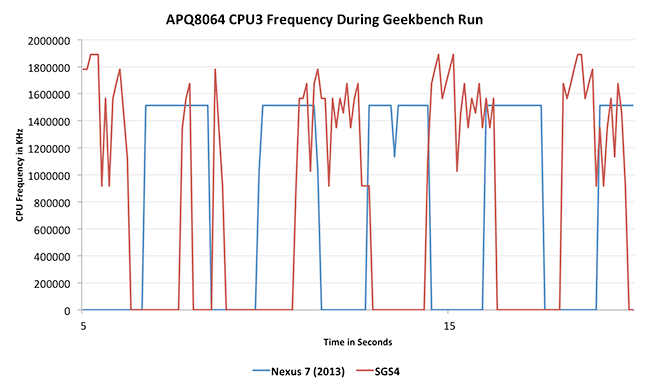








202 Comments
View All Comments
ESC2000 - Thursday, August 29, 2013 - link
I agree with everyone who is perplexed that you object to paying less. Also remember though that Asus manufactured these tablets and they certainly aren't working for no profit. I think I read somewhere that Asus gets $4 per nexus 7.... certainly not the $150 or whatever that Apple makes on each mini (not to mention the extra $100 for each storage upgrade) but it adds up.Of course they may be selling at or below cost and Google might just be paying Asus. Hopefully we won't all end up working as slaves to Google... -written from my happily-obtained at cost nexus 7 2013
jl0329 - Wednesday, October 9, 2013 - link
You are wrong on so many levels, I don't know where to begin...Arbie - Thursday, August 22, 2013 - link
Well, I may have to get used to it, but I don't want to. Hence the comment. And in what way does SD "suck"? Micro and standard SD work perfectly for me in about eight different devices, and have done so for years.
Wait - I just figured it out: you're putting the chip in backwards. Google for some help with that.
Arbie - Thursday, August 22, 2013 - link
You simply prove my point. Without a micro/SD slot you have to spend hours grinding your videos down just to fit the hardware AND keep a computer available (!!) to reload your tablet memory. That whole scenario is so infinitely more difficult than just snapping tiny chips in and out that it doesn't even parse. People - we should be bitching more about this, or we *will* have to get used to no SD.Arbie - Thursday, August 22, 2013 - link
Yeah, at about 1000x the size, weight, hassle, and fragility of a microSD card, it's not as elegant... That's exactly why we need micro/SD.BMNify - Thursday, August 22, 2013 - link
Anand will you please point out that Nexus devices are sold at-cost to the consumers, Google subsidised prices can't be compared with the other hardware manufacturers.sherlockwing - Thursday, August 22, 2013 - link
I guess Amazon doesn't count as "other hardware manufactuers" with their Kindle Fire Tablets?BMNify - Thursday, August 22, 2013 - link
Nope, Amazon doesn't count, now they can easily exit the market too if they want as their objective of cheap tablets as their delivery vehicle is achieved as mentioned by Brian Klug in one of the podcasts but they will still stay in the market so that they are not totally dependent on other ecosystems.sherlockwing - Friday, August 23, 2013 - link
If "cheap tablets as content delivery vehicle" is the Amazon model, it is the same as the Google model (use N7 to expand Android App user base, especially those that use Google Apps). If you declare "Amazon doesn't count" then Google doesn't count either by the same logic of yours.akdj - Sunday, August 25, 2013 - link
'especially those that use Google Apps'. That's the nail on the head. Google doesn't care about the 'Play Store"...in the sense of it being a money maker. Google is first and foremost an advertising company. The biggest in the world. The 'google apps' are exactly and precisely why they're selling these and their phones @ cost. It's also the same reason they release excellent iOS apps. For Google, your info...that's their gold mine. Nothing more, nothing less. Apple on the other hand IS a hardware manufacturer. Just so happens the App Store is extremely lucrative and would qualify as a Fortune 500 company on its own. As is iTunes. They make real, hard cash for those endeavors.Two completely different philosophies and goals
Amazon on the other hand...again, offering the Kindle @ cost allows for a quick and easy portal to purchase everything from diapers and peanut butter to the latest Stephen King novel or Tom Petty's new album. They're selling you a shopping bag that'll fit anything from the store (and your credit card) you'd like to buy
Just so happens...other vendors are now involving themselves attempting to compete with these two (3) different ways of thinking and running Android with their OEMs skin. Competition is good. These tablets in their current, usable and consumer available format have only been around for three years! As a 42 year old enjoyer of all things tech related, I find it a very exciting time to be involved with and 'into' technology. It's amazing what's happened in only 36 months....we've got more software available at our fingertips (with smartphones included) than any other time in history. 800,000+ apps on each platform....obviously with some parity. But just five years ago a decent game on a handheld gaming device was $59 on release! When I was a kid...my Mattell handheld football game cost my folks a good $30 bill for Christmas!
It's funny how 'religious' these OS debates have become. I own both Android and iOS devices....Work in Windows and Mac PCs...and I'm excited for everyone's press conference. How most of us that frequent Anand's site don't feel the same is beyond me. I'm just thankful the staff here is as passionate AND as objective as any human could ever be when it comes to technology review.
And to think....you don't pay a dime, most of you...to come enjoy their articles and in depth reviews anytime you choose???
Why such animosity? And why complain or argue? Debate is good...but so many of these tangent conversations seem to just 'not get it'. Seems ignorance has run rampant since the invention of the 'smart phone'....turned all of us into 'dumb people'
Just my cent and a half (I bought the new Nex7 myself...don't have a full two cents, I'm saving for the new 'mini' this fall;))